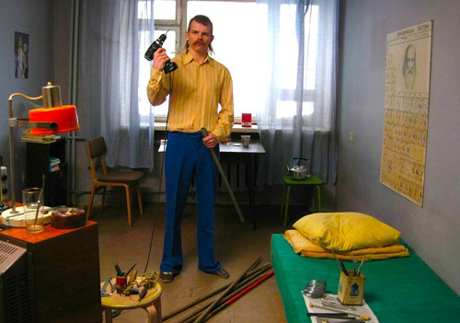Reviewed by Glenn Erickson
Don't let the title fool you, as the documentary Disco & Atomic War is not some kind of slick follow-up to our own The Atomic Cafe. The misleading title makes one think that the show might involve steely confrontations across the Iron Curtain. It's instead a fascinating account of a cultural clash inside the 'Soviet sphere of influence' in the latter years of the Cold War, the amusing, sometimes absurd story of the Soviet's failure to block out Western TV from the Baltic state of Estonia. In eighty minutes of news film and filmed recreations we come to a greater appreciation of what it means like to live in a totalitarian state, where the centralized government strives to 'protect' citizens from pernicious American propaganda.
Disco & Atomic War (Disko ja tuumasõda) is a Finnish film by Jaak Kilmi and his close associate Kiur Aarma, who grew up in the 1980s in the Estonian city of Talinn. Estonia was and had been a satellite of Russia. Supposedly independent, its leadership answered directly to Moscow. Estonia's internal security apparatus as well as its state broadcast departments were continually being summoned to account for themselves.
The problem for Moscow was Estonia's proximity to Finland. The capitol city of Helskinki is only a hundred miles or so across the Gulf of Finland, and Estonians in the city of Talinn have no difficulty picking up Finnish radio and TV broadcasts. Since the 1960s the northern part of Estonia has enjoyed a luxury denied other citizens within Soviet control: the ability to tune into Western broadcasts. The official ban on antennas was largely ignored; through the 1960s Estonians were able compare official state news coverage with a version being beamed in from the West. The Soviet news depicted the crackdown in Prague with shots of Czechs welcoming their Russian friends, with nary a soldier in sight. But the Helskini news showed unhappy crowds watching Russian tank battalions rolling into the Czech capitol. Estonians lived with two realities. The worldview broadcast from Finland had to remain unacknowledged, a secret hiding in plain sight.

The absurd fun begins in the late 1970s when TV comes to Talinn. The Estonians are fascinated by how much better the Finns seem to be living. What's more, the Finns carry U.S. programming, which presents an image of unending prosperity. Everyone on American TV is beautiful, well dressed, and lives in a consumer paradise. The Russians can't jam the signals and they can't eradicate the forest of TV antennas that spring up. Their own lame TV news claims that the Finnish TV signals are all lies. A bounty of food is seen on Finnish cooking shows, while grocery store shelves in Talinn are often bare. Estonian officials insist that the steaks and roast beef seen in close-up are really plastic fakes.
One fad that attracts Estonians is American Disco. They see pictures of the fashions but the music is difficult to access and there are few examples of what the dancing is all about. The state tries to co-opt the craze by sponsoring sanctioned Disco events. Line dancing 'Disco' lessons are arranged by instructors that haven't seen or heard the real thing. We see a news film clip of a crowd of Estonians performing what look like lame aerobics moves. The instructor in charge is almost apologetic: "I'm working in the dark, here."

Other official attempts to distract the citizenry from the allure of Finnish TV are just as ineffectual. Helsinki shows the old Billy Wilder comedy Ninotchka, which of course is a slap in the face to all things collective/Soviet/Stalinist. The pathetic Estonian TV re-dubs the movie, changing its dialogue to favor pro-Communist views. It's a dismal failure.
Director Kilme recreates amusing little scenes to illustrate personal memories. The authorities try a crackdown on rooftop antennas, which prompts an engineer to construct little hand-held antennas for use indoors. Buyers walk around the room or climb partially outside windows with the devices to try to get decent reception. The engineer converts Estonian TVs to the Finnish broadcast standard by custom-installing little chips that are smuggled into the country. His son types up homemade TV logs, and sells them to his schoolmates for pennies. He sees how much more the disc-smugglers earn, and is instantly indoctrinated in the Western art of earning more money by finding the right racket.
Disco & Atomic War touches on historical turning points in the relationship between Estonia and the crumbling Soviet Empire, which is spending too much money trying to keep up with Ronald Reagan's weapons development programs. We hear from Estonian and Finnish spokesmen that were employed within the broadcast industry. Unable to do anything to combat the 'culture leaks' in his country, the Estonian president invents more civic duties to keep the citizenry busy. In parts of the country too distant to receive signals from Finland, neighborhood meetings typically last for hours. In Talinn they're over in no time at all: everyone wants to get home to their TVs.

The most marvelous material involves a sort of 'coming of age' introduction to American TV. Estonians go nuts over the TV hit Dallas, in which American millionaires battle for power and their women dress like goddesses. Jaak Kilme's recreations make a wonderful mini-drama of the story of a little girl in a rural corner of Estonia where no TV of any kind reaches. As each Dallas episode airs, her young friend back in Talinn writes out the full plotline and mails it to her. She becomes an old-fashioned storyteller, with her family and neighbors waiting anxiously every week for a second-hand telling of what transpired with J.R. and company.
Also making a big impact is Star Wars, which reaches Finnish TV in the mid-'80s. We see photos of kids doing elaborate reenactments, in paper costumes. And small boys become obsessed with the fantasy action show Knight Rider. One boy seems to know every foreign car in Talinn. He spontaneously walks up to cars talking into his wristwatch, pretending that he's David Hasselhoff communicating with the computerized wonder car.
Finally there's the Finnish broadcast of the soft-core porn picture Emmanuele, which Disco & Atomic War elevates to a supreme national event. It's the late 1980s and for most Estonians pornography is still just a rumor. According to the show, the highways into Talinn were jammed as country cousins rushed to be in on the excitement. Radical politicos have long been claiming that free sex is an important part of social revolution, and in this case they were surely right.
From the first problems with radio broadcasts, the Soviets charged that the C.I.A. was bombarding their 'defenseless' citizens with capitalist propaganda. They continued to press the Finns but apparently found no political conspiracy in place. The Americans wisely realized that just watching the Finns absorb ordinary American culture would do the trick. Russian-style repression cannot possibly defeat our 'degenerate' market-driven entertainment and commercial enticements. They're too damned attractive.

Director Kilme's little recreations are like live-action cartoon panels. The kids are particularly cute. We feel sorry for the little rural girl when, after the cliffhanger of "who shot J.R.", the boy in Talinn can no longer send her letters. To keep her neighbors happy she makes up additional adventures of Dallas and continues reading.
Disco & Atomic War is a story about the Soviet Empire that doesn't involve suffering or violence. It won several coveted Best Documentary prizes at festivals, including Warsaw and Telluride. Its content is split between brief interview material, explanatory maps, real news film, and video samples of typical state broadcasts and their Finnish counterparts. The remarkable story often plays like a strange comedy, too absurd to be true. It also advances a positive, warm and inviting feeling about these Estonians -- once they get a taste of Western TV, they prove to be endlessly inventive.
Icarus Films' DVD of Disco & Atomic War is a good encoding of this entertaining and mind-opening documentary. The image quality is adequate, as is the audio. Much of the content had to be converted from old video formats, some of which can only look so good.
The show contains another short docu feature, 2008's Lotman's World by Agne Nelk. The hour-long animated film examines the ideas of semiologist Juri Lotman, a prolific Russian whose academic base was the University of Tartu in Estonia. The attractive cutout animation tries to present Lotman's complex theories and views in the school he founded, the Tartu-Moscow Semiotic School. As an untutored outsider to this specialization, I have to admit that I was intrigued by the show but had difficulty following the elevated intellectual concepts. Ms. Nelk's attractive animation is absorbing in itself.
On a scale of Excellent, Good, Fair, and Poor,
Disco & Atomic War DVD rates:
Movie: Excellent
Video: Very Good
Sound: Very Good
Supplements: Lotman's World (2008) short feature.
Deaf and Hearing-impaired Friendly?
YES; Subtitles: English but only for Finnish, Estonian and Russian speech (which is about 90% of the show).
Packaging: Keep case
Reviewed: April 18, 2014

Text © Copyright 2014 Glenn Erickson
See more exclusive reviews on the Savant Main Page.
The version of this review on the Savant main site has additional images, footnotes and credits information, and may be updated and annotated with reader input and graphics.
Return to Top of Page
|

